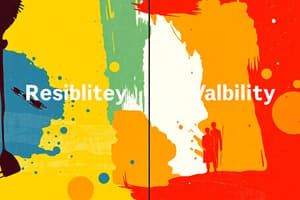Podcast
Questions and Answers
What is test validity?
What is test validity?
- The test is administered to a large sample
- The test measures what it is supposed to measure (correct)
- The test reflects a theory with empirical evidence
- The test gives comparable scores to other tests
What does content validity ensure?
What does content validity ensure?
All subtests and items measure what they are designed to measure
What is criterion-related validity?
What is criterion-related validity?
That the test can adequately predict performance on other tasks that most people agree requires intelligence.
What is concurrent validity?
What is concurrent validity?
Define construct validity.
Define construct validity.
What is test reliability?
What is test reliability?
Explain test-retest reliability.
Explain test-retest reliability.
What does parallel-forms reliability entail?
What does parallel-forms reliability entail?
What is split-half reliability?
What is split-half reliability?
Define internal consistency.
Define internal consistency.
What is inter-rater reliability?
What is inter-rater reliability?
What is standardisation and norms in testing?
What is standardisation and norms in testing?
Flashcards
Test Validity
Test Validity
The test measures what it is supposed to measure.
Content Validity
Content Validity
Ensures all subtests and items measure their intended constructs.
Criterion-Related Validity
Criterion-Related Validity
The test can predict performance on related tasks.
Concurrent Validity
Concurrent Validity
Signup and view all the flashcards
Construct Validity
Construct Validity
Signup and view all the flashcards
Test Reliability
Test Reliability
Signup and view all the flashcards
Test-Retest Reliability
Test-Retest Reliability
Signup and view all the flashcards
Parallel-Forms Reliability
Parallel-Forms Reliability
Signup and view all the flashcards
Split-Half Reliability
Split-Half Reliability
Signup and view all the flashcards
Internal Consistency
Internal Consistency
Signup and view all the flashcards
Inter-Rater Reliability
Inter-Rater Reliability
Signup and view all the flashcards
Standardisation and Norms
Standardisation and Norms
Signup and view all the flashcards
Study Notes
Test Validity
- Refers to the extent a test measures what it is supposed to measure.
- Content validity ensures all subtests and items address the specific material intended (e.g., a chapter test only covers that chapter's material).
- Criterion-related validity indicates a test's ability to predict performance on tasks that require intelligence, as agreed upon by most people.
- Concurrent validity assesses if a test yields scores that are comparable to other established valid tests.
- Construct validity demonstrates that a test accurately reflects the theoretical construct it is based on, supported by empirical evidence.
Test Reliability
- Test reliability indicates that a test consistently measures what it aims to measure across different administrations.
- Test-retest reliability involves administering the same test to the same group on different occasions and comparing scores, noting potential practice effects.
- Parallel-forms reliability entails using a different version of the same test to measure consistency.
- Split-half reliability is determined by dividing the test into two halves and ensuring their scores correlate.
- Internal consistency checks the correlation between different items of the same test to determine reliability.
- Inter-rater reliability assesses the agreement of results between different test administrators.
Standardisation and Norms
- Standardised tests are administered to a large and representative sample of the population under similar conditions and instructions, ensuring fairness.
- Norms provide mean scores of specific groups (ideally matched by age, background, etc.), allowing for valid comparisons among test takers.
- Cultural bias can lead to lower scores for individuals from cultures different from the one on which the test was originally standardised.
Studying That Suits You
Use AI to generate personalized quizzes and flashcards to suit your learning preferences.




